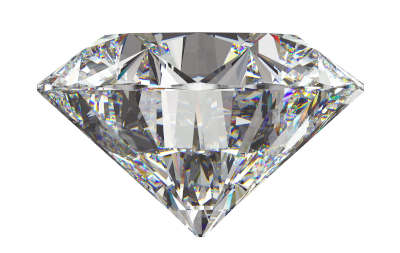The 4 C’s of a diamond are cut, color, clarity, and carat. They are the four primary parts of its attractiveness and composition. The human eye distinguishes an overall equilibrium of its parts and attributes incorporating the 4 C’s as well as other aspects.
Quality evaluation of the 4 C’s is done on a graded scale. There is common standard grading and terminology, but there are variations of them from different grading labs. In the U.S. and the world, the primary recognized and recommended entity that grades diamonds are the Gemological Institute of America.
A diamond’s worth and quality is determined by gradings of its 4 C’s. Sellers of diamonds commonly determine their diamond prices from diamond grading reports. Having a working knowledge of diamond grading fundamentals assists making comparisons of two like diamonds, but the most critical important factor is the overall appearance of a diamond when it is viewed by the human eye without assistance when it comes to its appeal and beauty. In this regard, possessing a basic working knowledge of the 4 C’s is critical for a diamond buyer to prevent investing your nest egg on diamond that is not visibly beautiful with respect to its cut, clarity, and color. Here are an explanation of the 4 C’s of a diamond.
CUT
The excellence of a diamond’s angles, proportions, finishing aspects, scintillation, fire, brilliance, and symmetrical facets are the components of a diamond cut. These components are the primary aspects that effect a diamond’s structural capability to sparkle and the totality of its visual attractiveness. A diamond’s cut is everything when it comes to is beauty.
The Diamond Cut grades scale of the Gemological Institute of America are Ideal, Excellent, Very Good, Good, Fair and Poor. The diamond grades of Ideal and Excellent indicate diamond cut angles and proportions for the highest fire and brilliance.
COLOR
The grading of the level of colorlessness or whiteness of a diamond is Diamond Color. Diamond Color grades from the Gemological Institute of America are D to Z. The most colorless is D and a Diamond Color that has perceptible yellow tint or brown is Z.
Diamond prices commonly are indicated in these Diamond Color grades. In many instances the price impact is substantial. In a significant number of cases the human eye is unable to discern two diamond color grades when place next to the other one. Even though that is the case the difference in price may be great.
The pricing of diamonds usually reflects these grades—sometimes significantly. In most cases, the naked eye cannot tell the difference between two adjacent color graded diamonds, though the price difference may be significant.
CLARITY
The evaluation of how clean a diamond is, is its Clarity. It is determined by the inclusions and blemishes of the diamond. The Gemological Institute of America grades diamond Clarity on its scales as follows:
- FL (Flawless)
- IF (Internally Flawless)
- VVS1 (Very, Very Slightly Included 1)
- VVS2 (Very, Very Slightly Included 2)
- VS1 (Very Slightly Included 1)
- VS2 (Very Slightly Included 2)
- SI1 (Slightly Included 1)
- SI2 (Slightly Included 2)
- I1 (Inclusions 1)
- I2 (Inclusions 2)
Imperfections of diamond’s Clarity are blemishes and inclusions. Factors of each are darkness, size, and location. Each of these have the ability of disrupt light as it goes through a diamond. When several significant imperfections of a diamond are present the beauty and brilliance is muted, robbing the diamond of high Clarity.
CARAT WEIGHT
Carat weight of a diamond is its weight, not the size of the diamond stone. For example a 0.20 gram weight diamond is a 1 Carat Diamond.
A one carat weight diamond is 200-milligram. 2 mg or 0.01 carat is a unit point measurement of one-hundredth of a carat. The price of diamonds increase as the carat weight increases, unless there are other factors impacting the value, such as poor clarity cut or color. Bigger ones are viewed as worth more and normally cost dramatically more.

